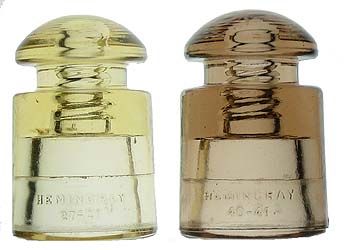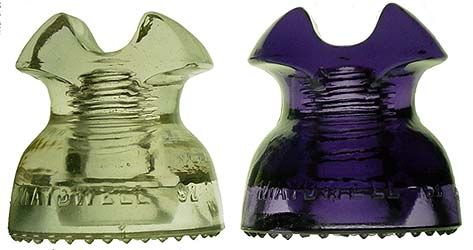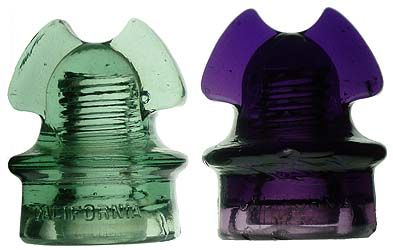
| 126-144 | 145-183 | 185-205 | 206-249 | 250-275 | 280-289 | 290-309 | 315-333 |
 |
Fake and Altered Insulators |
As insulator prices continue to increase, so does the incentive to defraud the collecting population. There are a number ways more common styles can be altered to increase apparent value. These activities are considered by the NIA as not in the best interest of the hobby as they affect the historical value of the insulators as well as run the risk of deceiving collectors. The NIA position is available in the Membership Handbook "Code of Ethics". The most typical are alterations to create color change. This issue is not new. Irridiation, Heat application, and coatings were utilized as far back as the mid 1970's to alter the color of glass insulators. Here are some excellent links for more information:
Irridiation is one of the tougher to detect techniques as the color change is fully through the glass and radiation penetrates dirt and stains, so the insulator may still have a very dirty used appearance but still be altered. Examples (Before & After):

Before & After: Hemingray CD 128 turns brown or a rose color. |

Before & After: Maydwell CD 252 turns a deep purple. |

Before & After: A sage California CD 260 turns royal purple. |
Heat treatment can be used to affect insulator colors. It is assumed that the heating reverses the color changes due to years in sunlight, but it is also possible that the altered color is not the original color but something else entirely. California purples have been shown to turn to yellow.
Glass Stains: People have colored insulators with glass stains for years. Recently some sellers have improved the stain process to where it is harder to detect. Most stained insulators are clear styles that have been colored a more exciting color. Educated collectors can quickly identify these as they are recent styles in unknown colors. Occasionally listed style will be mimicked by staining a more common insulator a listed color in the same mold series (ie: Aqua Hemingray-19 signal to cobalt blue). These require more care to detect -- scraping hard with a sharp knife will usually identify a stained piece - remember, some of the quality glass stains provide a very hard coating that may be difficult to detect.
Carnival Glass: A number of Hemingray and Corning Pyrex insulators were made at the factory in carnival glass. Three reasons are known:
Western Union patent to improve signal quality between rain and sun
Pyrex power insulators using the coating to reduce AM radio noise
Both Hemingray & Pyrex use as "marker" insulators to indicate high voltage or a specific circuit
Starting in the 1960's, some collectors began treating insulators with carnival glass after they were taken out of service. The CD 257 Hemingray clear "Mickey Mouse" insulators are the best example. No carnival CD 257 is known to be real, although they are still popular with collectors due to their attractive look. There are some problematic CD's that are known in original factory carnival as well as later application. These include the CD 230 and CD 168 Hemingrays. Experienced collectors can usually make a good judgment between original and later carnival coatings. It is also believed that Hemingray insulators that are brass bushed (Metal thimble in the pinhole) are probably original as reheating tended to break these.
|
Carnival CD 257 (These were made in the 1960's and 1970's and are considered altered) |
Mechanically altered insulators: By grinding and polishing, the shape of a common style can be converted to a new unlisted style. Bases have been ground off, wire grooves added, and threads have been removed. This is relatively rare and isolated but is included here for completeness.
Imitation Insulators: This area is one of the most controversial situations in the hobby today. Over the years there have been insulator "finds" that are considered suspect by many collectors. The problem with most is that no definitive proof exists, just circumstantial evidence and opinions of very educated collectors. Most of these insulators are designed to imitate rare pieces and thus sell in the hundreds to thousands of dollars. It is recommended that any collector dealing with more expensive pieces become educated by meeting and talking with experienced collectors about their opinions and thoughts to allow a more informed purchase decision. Here is a related link:
| 126-144 | 145-183 | 185-205 | 206-249 | 250-275 | 280-289 | 290-309 | 315-333 |
 Return to the insulator identification page
Return to the insulator identification page